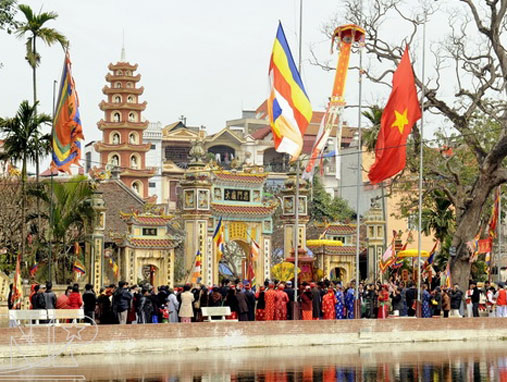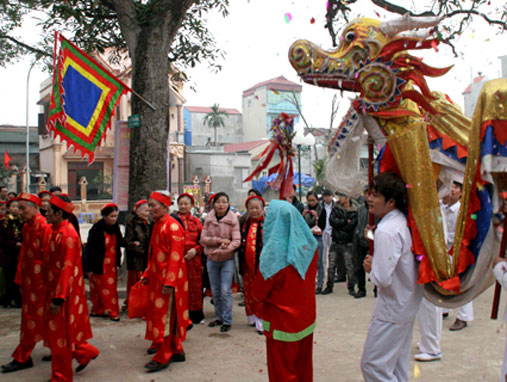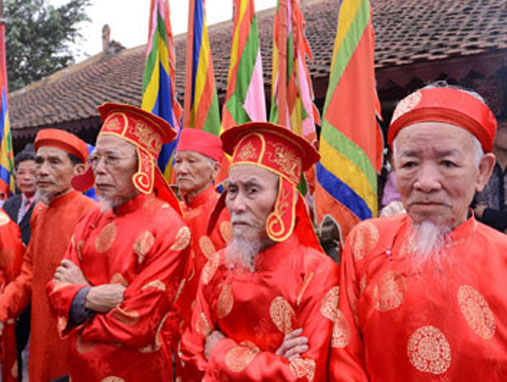Located about 8 km from the centre of the capital city of Hanoi, Trieu Khuc Village launches its spring festival on the 9 th day of the first lunar month of each year.
The focal points of Trieu Khuc Village’s festival are the two communal houses, i.e. Dinh Sac and Dinh Dai, the former housing the imperial honours conferred on the village genie by different dynasties and the latter, a little bigger, being the place of worshipping Bo Cai Dai Vuong Phung Hung as the titulary genie (the 8th century).
The Trieu Khuc Festival is held on the 9th to the 11th days of the first lunar month of the year. On the 9th day, the villagers solemnly gather at Dinh Sac to celebrate the ceremony of “Nhap Tich” (Naturalization), praying for permission to launch the festival from Bo Cai Dai Vuong. The procession parades from Dinh Sac to Dinh Dai, with a palanquin demonstrating the imperial robe of Emperor Phung Hung.

The rituals that take place at Dinh Dai are called “Te Hoan Cung”. The participants all wear attires made from the fabrics woven and embroidered with great sophistication by the villagers themselves. Amidst the festive atmosphere, the village troupe called “Doi Mua Bong”, consisting of one or two pairs of males disguised as females in colourful skirts and with heavy makeup, perform traditional dances to the melodious rhythm of the bells and drums played by an octet.
After the formal ceremony, the visitors may have a chance to watch festive games like the unicorn dance, wrestling, traditional operetta, etc.Trieu Khuc still preserves its village treasure: the Dragon Dance. Also, as the legend goes, this dance came into being when the villagers built the altar house to worship Bo Cai Dai Vuong Phung Hung.
The dance always gets an original start that cannot be found elsewhere (all males in the village are capable of performing this dance). The reputation of the Trieu Khuc Dragon Dance troupe is so widespread that it is more often than not requested to give performance at virtually all the grand festivities nationwide.

An original dance performance at the Triều Khúc Village Festival
On the morning of the 10th day, it is the villagers’ jubilant celebration at Dinh Dai. As the legend goes, it is a kind of ceremony to commemorate the coronation of Bo Cai Dai Vuong Phung Hung, when he ascended to the throne. And on the 11th day, the last day of the village fete, the villagers hold the closing ceremony.
Then comes the Flag Dance, which is believed to symbolize the Emperor’s selection of his brass hats to fight the invaders. The Flag Dance is alive with the fluttering of the flags, the beating of the bells, the gongs, and the drums, the blowing of the horns to mark the military march to the front of the impressive and valiant armies.

A large flag is hoisted up in the front yard of the communal house. Then two armies, well equipped with shields and spears, lances and scimitars, clubs and cudgels run to the front from two different directions, making a circle and then heading for the paddy fields, always turning to each other, face to face, coming to a halt only when they meet each other at the main axis on the yard.
They wield their arms, flourishing and brandishing them while coming back to the communal house and forming a closed circle, to the rhythm of the animated drumbeats and the noisy acclaim of the spectators. After that, all the actors of the Unicorn, the Dragon, the Flag Dances, the wrestlers as well as the villagers bow low to Him to bid goodbye to Him, and then share together the offerings of fruits and rice cakes, boiled pork and chicken, all tokens of their wealth and prosperity.
